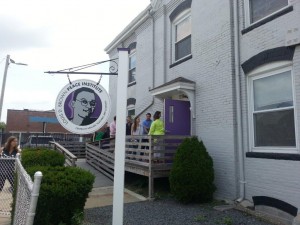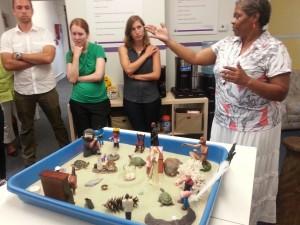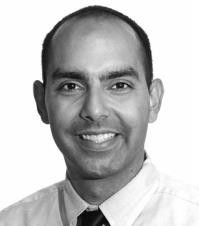Each summer, the incoming class of emergency medicine residents receive an SBIRT training and a tour of the surrounding community to better understand and serve the patients at Boston Medical Center. Below are thoughts from one resident on the day.
Boston Medical Center Emergency Medicine Residents’ Class of 2019: A UNITY TOUR TO MEET THE NEIGHBORS
On June 19th, 2015, the emergency medicine intern class of 2019 set out to discover the neighborhoods they will serve for the next four years. For many interns – several coming from as far as Hawaii and Ireland – it was their first time visiting the streets of Roxbury and Dorchester. Led by Dr. Ed Bernstein and Project ASSERT staff, the community tour was first organized three years ago with two purposes: (1) to visit and learn about the community’s resources; and (2) expose BMC’s newest doctors to the social ills that manifest in ED visits. “We wanted to welcome the interns to not only BMC but the community-at-large…to encourage them to be stakeholders in the community’s health. We want them to get involved and not be afraid to enter these neighborhoods because of rumors they hear…they are now a part of us,” said Ludy Young, a Project ASSERT supervisor of twenty-one years and Dorchester resident. With this notion of service and unity, twelve interns would soon begin a day full of inspiration, reflection, and initiation into the greater BMC family.
The morning began with a presentation on the Screening, Brief Intervention and Referral to Treatment (SBIRT) program at BMC, a public health intervention that has become a national model in addressing substance abuse disorders. The knowledge gained during these morning exercises proved helpful in understanding the role of Hope House, a residential treatment center for recovering substance abusers and the first visit of the day. “Visiting Hope House was a nice way to get exposed to some of the follow-up and transition options that are available for patients suffering with substance abuse issues.
Although there’s clearly a shortage of these kinds of facilities, and not enough high quality rehabilitation programs out there, it’s great to know that there are passionate people who are working to improve the lives of folks who are trying to get clean and make a change in their lives,” said Haley Thun, an intern from Atlanta, Georgia. The visit included the touching testimony of a former user, now clean for many years and expressing his gratitude for Hope House. “I can’t imagine how hard it would be to do the right thing for patients with substance abuse disorders in our ED if it weren’t for programs like this one,” continued Haley.
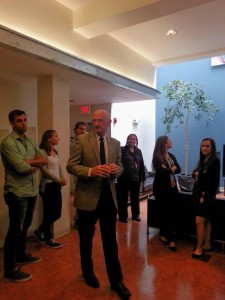
Fred Newton (c) Director of Hope House, the oldest, and now among the largest residential treatment programs in Massachusetts for adults with substance use disorder (SUD)
After thanking Hope House staff and residents for their generosity and time, the bus headed straight into the heart of Dorchester to visit the Louis D. Brown Institute. Founded in 1994 after the murder of fifteen year old Louis D. Brown, this non-profit organization is dedicated to educating young people about the value of peace and assisting victims with crisis management services and ongoing support. Louis’ mother, Ms. Tina Chery, is the founder and current president of the organization. Listening to her recount her personal tragedy and subsequent efforts to prevent similar violent acts left an indelible impression on everyone.
“The Louis D. Brown Peace institute provided a nice opportunity for us to get introspective and think about not only our own identities but also those of people in the communities we serve and how violence and trauma are affecting peoples’ lives,” said Jon Santiago, an intern from Boston.
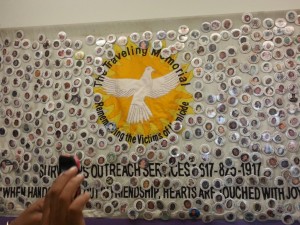
Louis D. Brown Peace Institute’s Traveling Memorial for victims of homicide in Boston put faces and stories behind those who tragically lost their lives
Before leaving, all those present were asked to participate in a self-reflection exercise involving a commemorative wall filled with the faces of gun violence victims. “The one particular thing that stood out to me was the wall that they had…it showed all the faces of all the young people my age who had been affected by gun violence. It was reality staring back at you,” said Konrad Karasek, an intern from Chicago, Illinois.
As we made our way to Merengue – a well-known Dorchester restaurant serving the best Dominican food north of the island – Joyce Stanley of Dudley Main Streets gave the interns a tour of Roxbury. After experiencing waves of immigrants, the now largely African-American neighborhood “serves as the heart of Black culture in Boston.” Despite a wave of violence in the 1980’s, many parts of the neighborhood are now flourishing as a result of investment and numerous urban initiatives. By the time we arrived at Merengue, bellies were starving for arroz blanco con habichuelas. Various representatives from the community spoke about their respective organizations – from tackling health disparities to LGBT healthcare issues – as food was served. Representatives from BMC’s nursing and social work departments also spoke of their roles and growing collaboration with the ED residents.
With food comas pending, the interns made their way back to BMC motivated by the day’s event. Many felt more connected and aware of the city’s challenges after the tour. “I think that it was an extremely useful experience to participate in that trip. After going to (medical) school in Boston, it was nice to see the world beyond our bubble in the South End. I rarely explored the neighborhoods south of BMC, but it is impressive to see how vibrant and diverse the communities are,” said Konrad. Others were able to place their new job responsibilities and the challenges faced by patients in a public health context.
Daniel Resnick-Ault, an intern from Brookline, Massachusetts said, “It’s one thing to care for patients in the hospital environment…but it’s another thing to see where they come from and understand the context of their social situation. You gain perspective.”
The community tour gave the intern class of 2019 a new-found sense of purpose and service. As they embark on their careers, it’s hearing the stories of patients that will provide perspective as they carry on with the daily grind of residency. Walking through the streets of Boston and meeting advocates across the city was an inspiring first step in the journey that awaits.
By Jonathan Santiago, MD (PGY 1)
